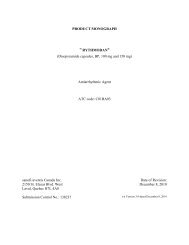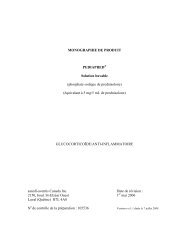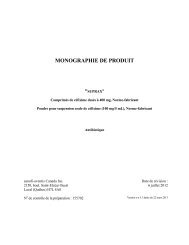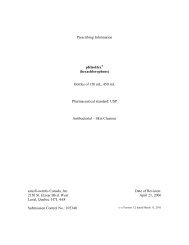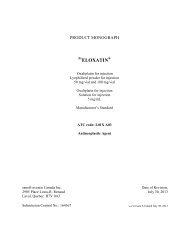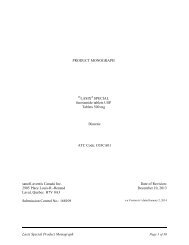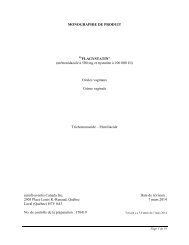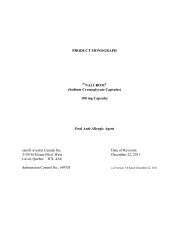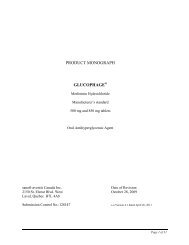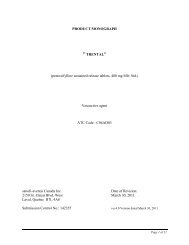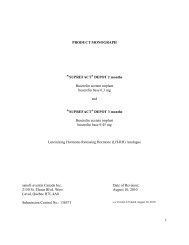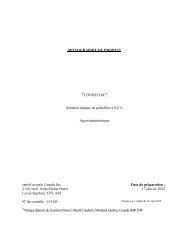Apidra (insulin glulisine) - Sanofi Canada
Apidra (insulin glulisine) - Sanofi Canada
Apidra (insulin glulisine) - Sanofi Canada
You also want an ePaper? Increase the reach of your titles
YUMPU automatically turns print PDFs into web optimized ePapers that Google loves.
Figure 2: Pharmacokinetic profile of <strong>insulin</strong> <strong>glulisine</strong> and regular human <strong>insulin</strong> in patients<br />
with Type 1 diabetes after a dose of 0.15 U/kg.<br />
INSULIN CONC - µU/mL<br />
When APIDRA was injected subcutaneously into different areas of the body, the timeconcentration<br />
profiles were similar with a slightly faster absorption when administered in the<br />
abdomen compared to the deltoid or thigh (see DOSAGE AND ADMINISTRATION.) The<br />
absolute bioavailability of <strong>insulin</strong> <strong>glulisine</strong> after subcutaneous administration is about 70%,<br />
regardless of injection area (abdomen 73%, deltoid 71%, thigh 68%). The Tmax for the abdomen<br />
was 44 min (range 27-69 min); 58 min for the deltoid (range 30-85 min), and 66 min for the<br />
thigh (range 35-108 min).<br />
Distribution and Elimination: The distribution and elimination of <strong>insulin</strong> <strong>glulisine</strong> and regular<br />
human <strong>insulin</strong> after intravenous administration are similar with volumes of distribution of 13 L<br />
and 21 L and half lives of 13 and 17 minutes, respectively. After subcutaneous administration,<br />
<strong>insulin</strong> <strong>glulisine</strong> is eliminated more rapidly than regular human <strong>insulin</strong> with an apparent half life<br />
of 42 minutes compared to 86 minutes.<br />
Special Populations and Conditions<br />
80<br />
60<br />
40<br />
20<br />
0<br />
APIDRA<br />
REGULAR<br />
0 1 2 3<br />
TIME - hour<br />
4 5 6<br />
Pediatrics: The pharmacokinetic and pharmacodynamic properties of <strong>insulin</strong> <strong>glulisine</strong> and<br />
regular human <strong>insulin</strong> were assessed in a study conducted in pediatric patients with Type 1<br />
diabetes (children [7 – 11 years, n = 10] and adolescents [12 – 16 years, n = 10]). The relative<br />
differences in pharmacokinetics and pharmacodynamics between <strong>insulin</strong> <strong>glulisine</strong> and regular<br />
human <strong>insulin</strong> in pediatric patients with Type 1 diabetes were similar to those in healthy adult<br />
subjects and adults with Type 1 diabetes.<br />
Gender: Information on the effect of gender on the pharmacokinetics of <strong>insulin</strong> <strong>glulisine</strong> is not<br />
available. However, in Phase III clinical trials in adults (n=2408), subgroup analyses based on<br />
Page 24 of 61



